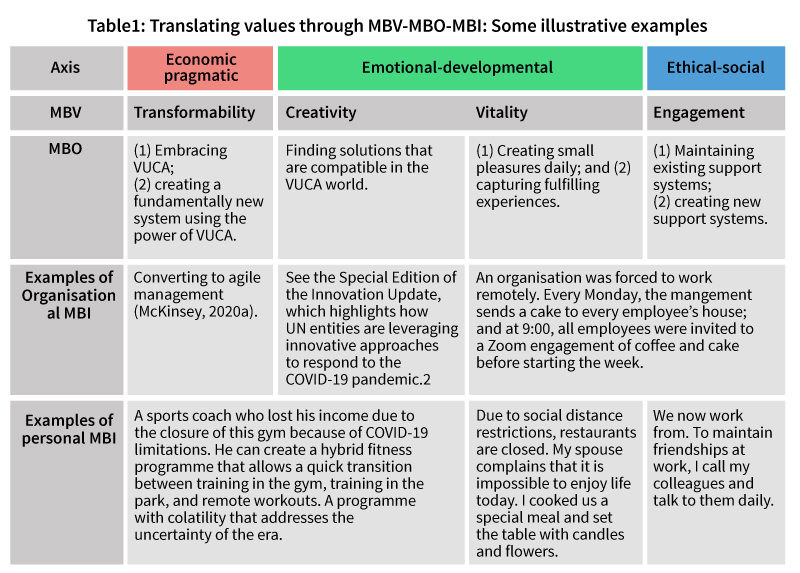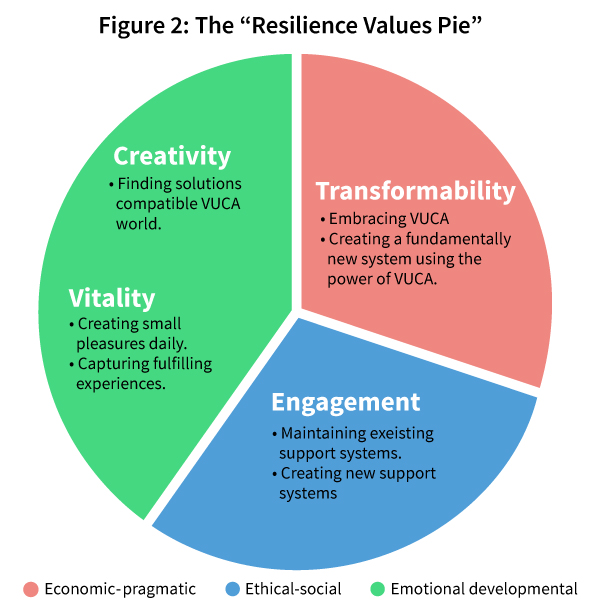By Anat Garti and Simon L. Dolan
The coronavirus (COVID-19) pandemic began at the end of 2019 in China and quickly spread globally. Millions of people around the world are infected and hundreds of thousands have died. The COVID-19 plague has brought uncertainty over the future and an understanding that the pandemic is far from over. Economic conditions are in great volatility. The complexity and ambiguity of the plague and its implications challenge the health systems in many countries and also result in a political quagmire. In short, the COVID-19 plague is an intense example of the VUCA world.
VUCA is an acronym that describes an environment of volatility, uncertainty, complexity and ambiguity1. Volatility means relatively unstable change; uncertainty implies a lack of knowledge as to whether an event will have meaningful ramifications; complexity suggests many interconnected parts forming an elaborate network of information and procedures; and ambiguity is the lack of knowledge as to “the basic rules of the game” (Bennett and Lemoine, 2014).
Since the late eighties and early nineties, pundits and leaders alike have asserted that we live in a “VUCA world”. A VUCA environment is challenging even the most able of business leaders, who may find their skills growing obsolete as quickly as their organisations change in this volatile, unpredictable landscape (Lawrence, 2013). At this time in history, assuming that we are learning from the past, we should have been ready for this world of uncertainty, and ready for the challenges that COIVD-19 presents. Unfortunately, we are not quite there.
Understandably, medical professionals and public health specialists are focused on taking care of individuals who are very sick, while containing the coronavirus’s spread in the general population (Sher, 2020). Less attention is given to managing the VUCA economics and psychological consequences of the COVID-19 crisis. This article uses the framework advocated by Dolan et al. of the “Managing by Values” (MBV) model and, more specifically, its triaxial model (Dolan, Garcia and Richley, 2006) to design a way to build resilience in the VUCA world in general, and the COVID-19 era in particular – resilience that facilitates reducing those related economic and psychological consequences.
Garcia and Dolan (1997) and Dolan and colleagues (2006) developed the “Managing by Values” (MBV) model to help organisations handle this VUCA world by developing a value-based configurational compass. In their book, they describe the evolution of the school of thought in management due to the increasing complexity in the environments that organisations operate in. Figure 1 summarises this evolution that started with MBI (Managing by Instructions) to MBO (Managing by Objectives) and finally to MBV (Managing by Values). The evolution is driven by the need to manage environmental and intra-organisational complexities (Dolan, Garcia and Auerbach, 2003; Dolan and Richley, 2006).
In the early 20th century, Management by Instruction (MBI) was an appropriate and adequate way to run an organisation. Change happened at a slower pace and therefore the way things were done in the past worked well enough to pass on to others. By the 1960s, change was accelerating to the point where more flexibility of action was required by managers. Thus, the introduction of Management by Objectives (MBO) enabled managers to agree on a direction and to choose their own strategy. As changes in the environment began to intensify (e.g., global competition, impact of technology, global economic crisis, etc.), MBO proved to be an insufficient strategy for managing in an interconnected and fast-paced VUCA world. Managing by Values (MBV) aims to help us create a set of values that directs us towards being productive, ethical and, all in all, satisfied human beings, as described in Dolan, Garcia and Richley (2006) or Dolan (2011, 2019 and 2020). The model argues that a full, balanced and healthy life needs to include three groups of values: the economic pragmatic group, the ethical-social group and the emotional-developmental group; this is the essence of the 3Es Triaxial Model of Values. We will use these three groups of values to develop the concept of resilience.
Resilience was originally introduced by Holling (1973); he stated: “Resilience determines the persistence of relationships within a system and is a measure of the ability of these systems to absorb changes of state variables, driving variables, and parameters, and still persist” (p 17). Brand and Jax (2007) review the variety of definitions proposed for “resilience” and concluded that there are two distinct meanings of resilience. In the first, resilience is defined as the time required for a system to return to an equilibrium point following a disturbance event. The second defines resilience as the amount of disturbance that a system can absorb before changing to another stable regime, which is controlled by a different set of variables and characterised by a different structure. In this article, we refer to the second definition, in the sense that resilience incorporates the capacity of social-ecological systems to cope with, adapt to, and shape change, and learn to live with uncertainty and surprise (Folke 2003, 2006). Managing by value with the three groups of the 3Es Triaxial Model encourages developing values which will help build the capacity to cope with, adapt to, and shape change, and learn to live with this COVID-19 VUCA era.
The economic pragmatic group deals with values that direct behaviour in an effective manner which is instrumental to achieving our goals in life or at work. This group includes values such as excellence, planning, diligence, efficiency, etc. Developing resilience means having transformability as an economic-pragmatic value. Walker and colleagues (2004) and Folke and colleagues (2010) emphasise the importance of transformability for building resilience. They argue that transformability is the capacity to create a fundamentally new system when ecological, economic or social (including political) conditions make the existing system untenable. This value should be the answer to our need for control and certainty. Instead of trying and failing, controlling and predicting the COVID-19 VUCA life, which may lead to desperation and the development of “learned helplessness”, we should embrace the volatility, uncertainty, complexity and ambiguity of the situation, be creative and derive a new system. Instead of waiting for our life to “return to normal”, we have to transform our way of thinking and see the VUCA world as the next normal.
We argue that “creativity” is an important component of the emotional-developmental axis. In this VUCA situation, people often do not consider this value group seriously. They are so busy in the struggle merely to survive that they block the constructive emotional development. The underlying values in this axis are oriented towards constructing a life filled with interest, with passion and with creativity, despite the fact that this last is difficult to define. Creativity in the VUCA world can be viewed as a new sense of coping, adapting and solving novel problems. In this environment, creativity needs to be viewed out of the box; hence, it needs to surpass inhibitions, overcome the traditional way of the past of relying on experience, and break away from habitual assumptions and routines. The clear indicator of the need for creative solutions is apparent in the ongoing experience with the continuing waves of COVID-19 infections. Having succeeded in the first wave is not a guarantee that the same remedies will work again in the second wave. Actually, the facts show that many countries are failing in generating this creative solution in the next round, and the pandemic is becoming worse. That may be the reason that children are more creative than adults (Runco, 2014); they transform our way of thinking and see the VUCA world as the new normal, and are not bound in their imagination to the previous “normal” life.
The COVID-19 challenge, for most individuals, organisations and nations, can be reduced to tackling the issue of survival. Thus, another emotional-developmental value that is required precisely in this period is vitality. Vitality is one’s conscious experience of possessing energy, enthusiasm, spirit and aliveness (Ryan and Frederick, 1997). Vitality will bring resilience, since vitality is our psychological survival ally. By vitality, we intend to create the small pleasures on a daily basis and capture the corresponding fulfilling experiences. Vitality can be instrumental and enhance resilience only when it breaks away from yesterday’s world (which no longer exists) and tackles the new VUCA world positively, yet realistically.
The third axis in the 3Es Triaxial Model is the ethical-social group of values. This group deals with relationships, values that direct behaviour of thoughtfulness, influence, loyalty, tolerance, etc. Developing resilience during the COVID-19 VUCA era means having engagement as one of the top ethical-social values. The COVID-19 VUCA era generates an extreme amount of ongoing stress. According to Dolan’s model of acute or prolonged (chronic) stress (Dolan, 2006), there are factors that can either filter or amplify the stress reaction. Stress means “wear and tear” to the body (physically) or the soul (emotionally). Any strategy addressed to minimise the wear and tear can enhance resilience. One main factor in this regard is the critical need for support systems. Research shows that effective support systems can play an important positive role, leading to fewer signs and symptoms of stress (Dolan et al., 1992; Dolan and Renaud, 1992). Since COVID-19 requires us to implement social distance, developing and maintaining our support systems is an essential value. There are attempts to replace social support virtually, which seems to be effective to some degree, but not for everyone.
Values are an abstract concept. To build economic and psychological resilience to COVID-19, we have to translate these abstract concepts into concrete behaviours. For this translation process, we will use Garti’s “behave your values” model (Garti and Dolan, 2019). The model borrows from the evolution of management by instruction (MBI) to management by objectives (MBO) and then to the present concept of managing by values (MBV). For translating values into behaviour, the model proceeds in the opposite direction, dismantling the abstract value identified in the (MBV) phase, into concrete objectives (MBO) and finally into one or several contingent context specific behaviours (MBI).
It is important to note that the objectives must be understood in light of the values and not as stand-alone, otherwise we return to MBO of the sixties. The objectives interpret the spirit of value. They are flexible and come to serve the value. They are the means, and value is the goal. The instructions that follow are examples of ways in which the objectives that translate the essence of the value can be implemented. They should not be seen as instructions, as in MBI.
Table 1 displays the way we recommend dismantling the values noted to objectives and examples for some specific behaviours.

In summary, the resilience value system is recommend for living in the COVID-19 era. To be more specific, we propose to use the Values Pie chart (Garti and Dolan, 2019). The Values Pie integrates the 3Es Triaxial Model and the “behave your values” model, as has been described above, and creates a clearer picture for the way one wants to build resilience. The Values Pie has four ingredients. (1) The correct portion of each axis in the value system. Remember that in the Triaxial Model, the pie has to contain all three axes divided in any way that suits the system. (2) Each slice of the pie contains the values of that axis. (3) The size of the font of each value expresses the importance of the value for the Values Pie owner. A value that is expressed in a small font represents a relative less important value compared to a value that is expressed in a bigger font. (4) Each value has its objectives (MBO). Given that the Values Pie portrays a holistic view of the axes distribution, the values that are in each axis show their importance and their objectives. The Resilience Values Pie recommended for living in the COVID-19 era is displayed in figure 2.
 Conclusions and implications
Conclusions and implications
Today’s world is best described by the concept of VUCA (volatility, uncertainty, complexity, ambiguity). The coronavirus pandemic has created unprecedented disruption and stress at the personal level as well as for organisations and their workforces. Entire countries are affected by it as well. Only with time will we learn and understand the real devastation that has happened (and is still growing strongly).
There are numerous articles, papers, books and even TV documentaries on the suffering, the stress and the devastation. A recent McKinsey report says that COVID-19 is “first and foremost a human tragedy, affecting hundreds of thousands of people”. Furthermore, at the macro level, “it is upending entire industries” (McKinsey, 2020b). At the very personal level, it is affecting people’s physical and mental health, as well as their livelihoods. Meanwhile, there are no definite answers about how long the disruption will last, when the outbreak might weaken and when it will come back.
Against this gloomy background, we are attempting to propose a focus on positivity by creating hope. We have chosen to focus on the concept of resilience. Resilience can apply to individuals, to teams, organisations or an entire community. Building a resilient workforce in an organisation, for example, is one of the best defences against adversity, helplessness and even numbness in a VUCA world.
Resilient organisations are those that can successfully bounce back and grow from adverse experiences. Resilient people do the same. Thus, business leaders over the past twenty years have adopted the US Army War College’s concept of VUCA as a way to describe the massive change and disruptions that have continually rocked organisations, markets and governments around the world. VUCA has become the new normal, especially in light of COVID-19, and leaders have realised that there is little we can do to change these kinds of external factors; we can only prepare and respond by strengthening the internal factors.
The understanding of the configurations of the values on which this paper focuses can lead to the emergence of a targeted, resilience-based behaviour. In the paper, we move from the abstract theory of resilience to the concrete way of illustrating the value-driven compass. By adopting the behaviours and strategies of these highly resilient people, we can create an entire workforce that will become better equipped to face adversity with a positive outlook, recover quickly and contribute in innovative and creative ways to driving value, even in such volatile times.
About the Authors
 Dr Anat Garti is a social psychologist, couple and family therapist, management consultant and coach. She is the chief psychologist of the “Israel Values Center”: www.values-center.co.il . Contact anatgarti@gmail.com
Dr Anat Garti is a social psychologist, couple and family therapist, management consultant and coach. She is the chief psychologist of the “Israel Values Center”: www.values-center.co.il . Contact anatgarti@gmail.com
 Prof. Simon L. Dolan is a researcher, author, management consultant and very solicited speaker. A prolific author (over 75 books), the creator of the Leading, Managing and Coaching by Values school of thought. Recently he has created and serves as the president of the Global Future of Work Foundation. He commutes between Barcelona (Spain) and Montreal (Canada) and delivers speeches in four languages throughout the world via his “Thinking Heads” agency (www.thinkingheads.com ). To learn more about him: www.simondolan.com. Contact: info@simondolan.com
Prof. Simon L. Dolan is a researcher, author, management consultant and very solicited speaker. A prolific author (over 75 books), the creator of the Leading, Managing and Coaching by Values school of thought. Recently he has created and serves as the president of the Global Future of Work Foundation. He commutes between Barcelona (Spain) and Montreal (Canada) and delivers speeches in four languages throughout the world via his “Thinking Heads” agency (www.thinkingheads.com ). To learn more about him: www.simondolan.com. Contact: info@simondolan.com
References
- The acronym VUCA, according to many sources, originated in the US military (Whiteman, 1998).
- https://www.un.org/sites/un2.un.org/files/2020-06_-_unin_quarterly_innovation_update_-_second_covid-19_special_edition.pdf
- Bennett, N., and Lemoine, G.J. (2014). What a difference a word makes: Understanding threats to performance in a VUCA world. Business Horizons, 57(3), 311-317.
- Brand, F.S., and Jax, K. (2007). Focusing the meaning (s) of resilience: resilience as a descriptive concept and a boundary object. Ecology and society, 12(1).
- Dolan, S.L. (2006). Stress, self-esteem, health and work. Palgrave-MacMillan.
- Dolan, S.L., (2011). Coaching by Values: A Guide to Success in the Life of Business and the Business of Life. iUniverse. Bloomington, IND.
- Dolan, S.L., (2019). Más coaching por valores. Madrid, LID editorial.
- Dolan, S.L., (2020). The secret of Coaching and Leading by Values: How to ensure alignment and proper realignment. Routledge.
- Dolan S., Garcia S., and Auerbach, A., (2003). Understanding and Managing Chaos in Organizations, International Journal of Management; Mar 2003; (20), 1; 23-30.
- Dolan S., Garcia S., and Richley, B. (2006). Managing by values: A Guide to Living, Being Alive, and Making a Living in the XXI Century. Palgrave MacMillan, London (U.K).
- Dolan, S.L., and Renauld S., (1992). Individual, organizational and social determinants of managerial burnout: A multivariate approach. Journal of social behavior and personality (7) :95-110.
- Dolan, S.L., and Richley, B., (2006). Management by values (MBV): a new philosophy for a new economic order, Handbook of Business Strategy Volume 7 Issue 1.
- Dolan, S.L., Van Ameringen, M.R., and Arsenault A., (1992). “Personality, Social Support and Workers’ Stress” Relations industrielles / Industrial Relations, vol. 47 (1):125-139.
- Folke, C. (2003). Freshwater for resilience: a shift in thinking. Philosophical Transactions of the Royal Society of London. Series B: Biological Sciences, 358(1440), 2027-2036.
- Folke, C. (2006). Resilience: The emergence of a perspective for social–ecological systems analyses. Global environmental change, 16(3), 253-267.
- Folke, C., Carpenter, S.R., Walker, B., Scheffer, M., Chapin, T., and Rockström, J. (2010). Resilience thinking: integrating resilience, adaptability and transformability. Ecology and society, 15(4).
- Garcia S., and Dolan S.L. (1997). La dirección por Valores . Madrid. McGraw Hill
- Garti, A., and Dolan, S.L. (2019). “Managing by Values” (MBV). The European Business Review.
- Holling, C.S. (1973). Resilience and stability of ecological systems. Annual review of ecology and systematics, 4(1), 1-23.
- Lawrence, K. (2013). Developing leaders in a VUCA environment. UNC Executive Development, 1-15.
- McKinsey (2020a). Agile resilience in the UK: Lessons from COVID-19 for the ‘next normal’. October 14. https://www.mckinsey.com/business-functions/organization/our-insights/agile-resilience-in-the-uk-lessons-from-covid-19-for-the-next-normal
- McKinsey (2020b). COVID-19: Implications for business – Executive briefing. October 7. https://www.mckinsey.com/business-functions/risk/our-insights/covid-19-implications-for-business
- Runco, M.A. (2014). Creativity: Theories and themes: Research, development, and practice. Elsevier.
- Ryan, R.M., and Frederick, C. (1997). On energy, personality, and health: Subjective vitality as a dynamic reflection of well‐being. Journal of personality, 65(3), 529-565.
- Sher, L. (2020). The impact of the COVID-19 pandemic on suicide rates. QJM: An International Journal of Medicine.
- Walker, B., Holling, C.S., Carpenter, S.R., and Kinzig, A. (2004). Resilience, adaptability and transformability in social–ecological systems. Ecology and society, 9(2).




































